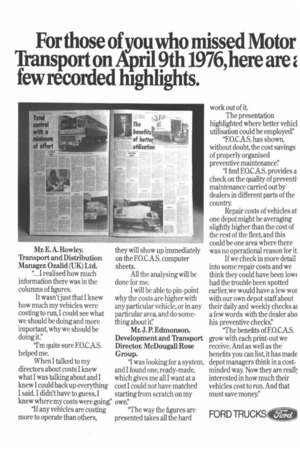For those of you who missed Motor Transport on April 9th 1976, here are few recorded highlights.
Page 94

Page 95

If you've noticed an error in this article please click here to report it so we can fix it.
Mr. E. A. Rowley. Transport and Distribution Manager. 0 zalid (UK) Ltd.
"...I realised how much information there was in the columns of figures.
It wasn't just that I knew how much my vehicles were costing to run, I could see what we should be doing and more important why we should be doing it."
'I'm quite sure EO.C.A.S. helped me.
When I talked to my directors about costs I knew what I was talking about and I knew I could back up everything I said. I didn't have to guess, I knew where my costs were going'
"If any vehicles are costing more to operate than others, they will show up immediately on the EO.C.A.S. computer sheets.
All the analysing will be done for me.
I will be able to pin-point why the costs are higher with any particular vehicle, or in any particular area, and do something about it' Mr. J. P. Edrnonson. Development and Transport Director. McDougall Rose Group.
"I was looking for a system, and I found one, ready-made, which gives me all I want at a cost I could not have matched starting from scratch on my own:'
'The way the figures are presented takes all the hard work out of it The presentation
highlighted where better vehicl utilisation could be employed:' "F.O.CA.S. has shown, without doubt, the cost savings of properly organised preventive maintenance:' "I find EO.CAS. provides a check on the quality of prevend maintenance carried out by dealers in different parts of the country
Repair costs of vehicles at one depot might be averaging slightly higher than the cost of the rest of the fleet, and this could be one area where there was no operational reason for it If we check in more detail into some repair costs and we think they could have been low( had the trouble been spotted earlier, we would have a few wor with our own depot staff about their daily and weekly checks ai a few words with the dealer abo his preventive checks:' 'The benefits of EO.CA.S. grow with each print-out we receive. And as well as the benefits you can list it has made depot managers think in a costminded way. Now they are reall] interested in how much their vehicles cost to run. And that must save money?'
Introduction
THE INROAD made by Ford into Britain's truck market really began with the introduction of the D-Series in 1965 and combined with the introduction of the Phase II D1000 models in 1967.
At the time of the introduction, the all-steel tilt cab was a real pacesetter and even today with close to 400:000 units produced it is still very com petitive. The cab is well. styled and comfortable and the whole vehicle has earned an enviable reputation for good fuel consumption and generally low operating costs.
But the truck itself is only part of the story, for during the past 10 years Ford has created a very strong truck dealer network. Today Ford has 141 Truck Specialist Dealers who collectively have invested no less than £30 million in new truck facifities and equipment since the inception of the TSD network in the mid-Sixties.
Together the well proven D-Series product and the very well equipped Truck Specialist Dealer network provides a sales and support service to vehicle operators which is hard to equal.
Cover picture Some 65 per cent of all D-Series are exported to countries all over the world including every Western European country except Spain. The picture shows a 01614 rigid operating in Finland where Ford is the overall commercial vehicle leader.


























































































































